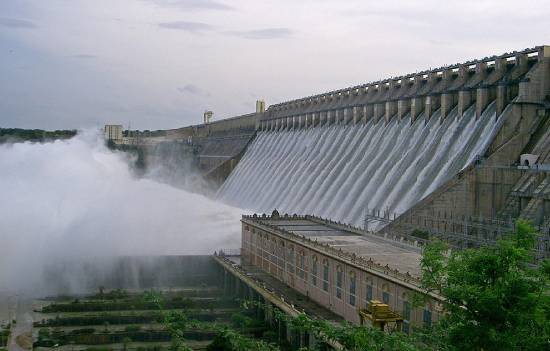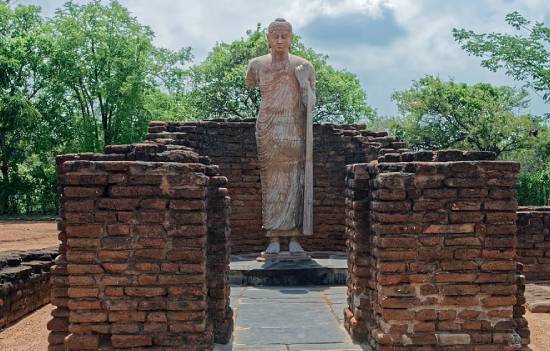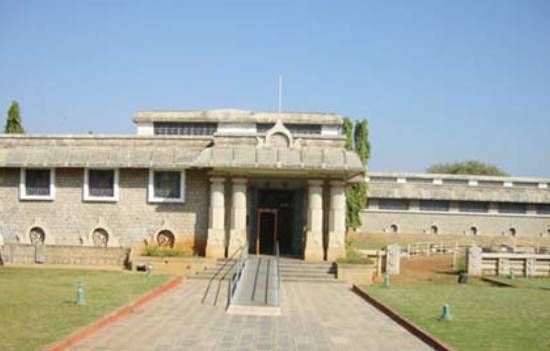- Know
about the importance of Nagarjunakonda. It means an island in the memory of a
great Guru and establisher of the Mahajani Buddhist branch. At some point it was
a great religious centre with mostly Buddhist settlements.
Nagarjuna was a great teacher of Mahajani Buddhist cult in 200 CE. ‘Konda’ means an island. Thus Nagarjunakonda means an island in the memory of a great Guru and establisher of the Mahajani Buddhist branch. The island is just a submerged hill of Nallamala range close to the right bank of Krishna river. It is situated in Macherla Mandal of the Guntur district in Andhra Pradesh. The place was famous as Bijaypuri in ancient times.
The
historical Krishna valley was completely submerged when a dam was built over
the river Krishna. The valley is surrounded on three sides by the beautiful
Nallamallai mountain ranges. This is the third man-made lake of the world and
the island is approachable by motor launches operating from Bijaypuri south.
Today
Nagarjunakonda is the meeting place of modernity and antiquity. About 1,800
years ago, it was a great religious centre promoting Brahmanical and Buddhist
faiths. It was an extensive Buddhist settlement nourishing several sects of
Buddhism. In the Hindu Pantheon of Dashavatar, the Buddha is the ninth
incarnation.
This article was
first published in the Bhavan Journal.
Sri
S. Venkataramayya, a teacher, discovered certain objects from the Krishna
valley area and informed the Archaeological Society of India about it. They excavated
a few places in the area and came to the conclusion that this was a site of a
great civilisation. With the decision of constructing a dam across the river
Krishna, the valley was subjected to intensive large-scale excavation to
salvage the prestigious relics for well over six continuous years (1954-1960).
 Nagarjuna Dam.
Nagarjuna Dam. Due
to systematic excavation in 130 sites over 24 square kilometres, a cultural
sequence from the early Stone Age to medieval times was established. The
remains of 70 structures and an array of antiquities in various media,
including the reliquaries of the master and the disciples, were discovered. To
avoid total submergences, some of the outstanding structures were reconstructed
in the island and on the eastern bank of the lake. The antiquities are
exhibited in the museum. The reconstruction of the original material following
similar ecosystem and alignment is the first of its kind in India.
It
emulates the world-famous preservations of the Abu Simbel temples when the Aswan
Dam was constructed in Egypt. The Abu Simbel temples were constructed by
Pharaoh Ramses II in 13th century BCE. Abu Simbel is now relocated on the
western bank of Lake Nasser, about 230 km from Aswan. It consists of two
massive rock-cut temples. The twin temples were originally carved out of the mountain
side in 13th century BCE. The sanctum sanctorum of the main temple contains the
deities (statutes) of Ptah, Amun-Re, Ra-Horakhty and Ramses II himself. The
most notable feature of the temple is the four colossal statues of Ramses II on
the outside, each 21 metres high. The other temple is of the chief queen of
Ramses II, Nefertari. Hathor is the presiding Goddess of the temple. The
temples were dismantled, moved to a higher ground and reassembled. Abu Simbel
was inaugurated in its new location on September 22, 1968. It is now a World
Heritage site and a great tourist centre.
The ride to Nagarjunakonda itself is fairy tale-like—enchanting, wonderful and beyond imagination. The green Nallamalai mountain range on both sides of the lake, the bluish water of the lake, its small ripples and the gentle bridge—all this transports the traveller to another world.
A
six-metre high wall surrounds the whole of the island and there are six gates.
The Museum simulates a Buddhist vihar. It is located amidst the remains of a
medieval fortification in the northern part of the island spanning about 2.5 km
in the east-west direction and one km in the north-south direction.
The museum presents artefacts of all cultural periods through which the valley has passed, in five well-organised galleries. Carved lime stone slabs, sculptures, inscriptions
and other antiquities of 3rd and 4th century CE constitute the majority of exhibits.
The majestic six-foot tall monolithic Buddha in the standing posture of 200 CE,
the original Buddha brought from the excavation site, is spellbinding. It
appears as if he is welcoming and blessing the visitors.
 A portion of the
Mahachaitya. The original Buddha is in the museum.
A portion of the
Mahachaitya. The original Buddha is in the museum.He
is moderately well-built, has a serene face and well-modelled round shoulders,
the long robes falling in systematic folds following the body contour and
drapes gently, leaving a shoulder bare. The right hand is positioned in
symbolic gesture of the Abhaya Mudra.
Apart
from the Lord Buddha, both the side walls of Gallery I are full of the life
history of Buddha, as well as Jataka stories. Some panels exhibit the objects
of the early stoneage to the Megalithic period from 3000 BCE.
 Entrance to Museum.
Entrance to Museum. Gallery
II and IV are located in the main Hall. The Galleries exhibit the decorated
drum slabs, dome slabs, cornice beams and other architectural units of stupas.
A few Brahmanical sculptures besides a variety of earthen wares of the Ikshvakus
and subsequent periods are also there. The entire life story of the Buddha
along with the popular miracles he performed are the subjects of the carvings.
The Brahmanical sculptures displayed are of Kartikeya and his consort Devasena,
a Siva Linga, Sati, Vidyadhars, war scenes, children playing, etc. along with
some ceramic articles.
In
Gallery III, the Hall shows the panoramic view of the submerged valley along
with models of secular and religious places. On the floor of the hall there is
the 6.01 sq. m. model of the valley locating the 130 excavated sites, and along
the walls, models of important excavated sites and remains. These include
Neolithic and Megalithic burials, stupas, Mahastupas, Viharas, Brahmanical
temples, amphitheatre (stadium), bathing ghats, etc.
Gallery V contains select specimens of the epigraphs and medieval sculptures. The writings are mainly in Bhrami, some are in Prakrit or in Sanskrit. There is one shilalipi by Gajpati Purushottam Dev written in Telugu. Greek soldiers and their currency are also displayed in this gallery. There are various excavation sites that can be explored like the burial ground of the Megalithic period of 3rd millennium BCE. There is a hole, inside which there are 21 small holes and out of them, 19 skeletons were discovered. In the burial place, earthen pots, a few useful articles made of iron are there. It matches with the Egyptian belief that they may need these things in the ‘afterlife’.
At the Maha Chaitya, a board specifies that it was built in the time of the Satakarni regime. Satakarnis were ruling the area before Ikshvakus. The newly made exact replica of Lord Buddha’s standing idol can be seen there.
The
Ikshvaku kings believed both in Siva and Vishnu. But their queens believed in
Buddhism, and all the viharas, stupas and chaityas are built by them. The chaitya
here has the silver stupa from which the relic of Lord Buddha in a golden farua
was discovered. The reliquaries of Nagarjuna and his principal disciples were
also there in this chaitya; small rooms for students, big rooms for teachers, classrooms
and prayer rooms are there. Apart from the silver stupa, three additional
stupas are there in the premises.
Many
viharas are there in the island, a few famous ones are Sighala stupa, Swastik
Chaitya, etc.
Perhaps
when the Buddha was alive, Buddhists had come to this place. After the second
Buddhist council was held in Vaisali, Mahajani Buddism took birth and
Nagarjuna
was the key figure. Due to his ardent efforts, the valley turned out into the
nucleus of Buddhist studies. He was a great teacher, and kings, elites and zealous
missionaries alike flocked to the place from far and near and it became a great
centre of learning.
 Ruins of a temple.
Ruins of a temple. A
few temples are also shifted here, mainly the ones dedicated to Siva,
Kartikeya, Vishnu and Devi. Some 15th century temples are also here. Near the
museum, the temple of Sri Nageswaram was built by Gajapati Sri Purushottam Dev.
Two temples of Lord Vishnu are also there, one near the Maha Chaitya and
another, near the pond.
Previously
they were Jain temples, converted to Vishnu temples by Raja Krishna Deva Roy.
The bathing ghat and the Ashwamedha Avabhrita tank of the Ikshvaku period looks
as if they were present here from the very beginning. The stadium is just like
the present-day stadiums; the temple of Ma Hariti is nearby. The palaces, some
city portions, cottages, and the remains of temples are also restored.
This article was first published in the Bhavan’s Journal, April 1, 2025 issue. This article is courtesy and copyright Bhavan’s Journal, Bharatiya Vidya Bhavan, Mumbai-400007. eSamskriti has obtained permission from Bhavan’s Journal to share. Do subscribe to the Bhavan’s Journal – it is very good.
Also read
1.
ASI Museum
Nagarjunakonda
2. Albums of
Buddhist Holy Places on site
3.
Articles on
Buddha Vakhya